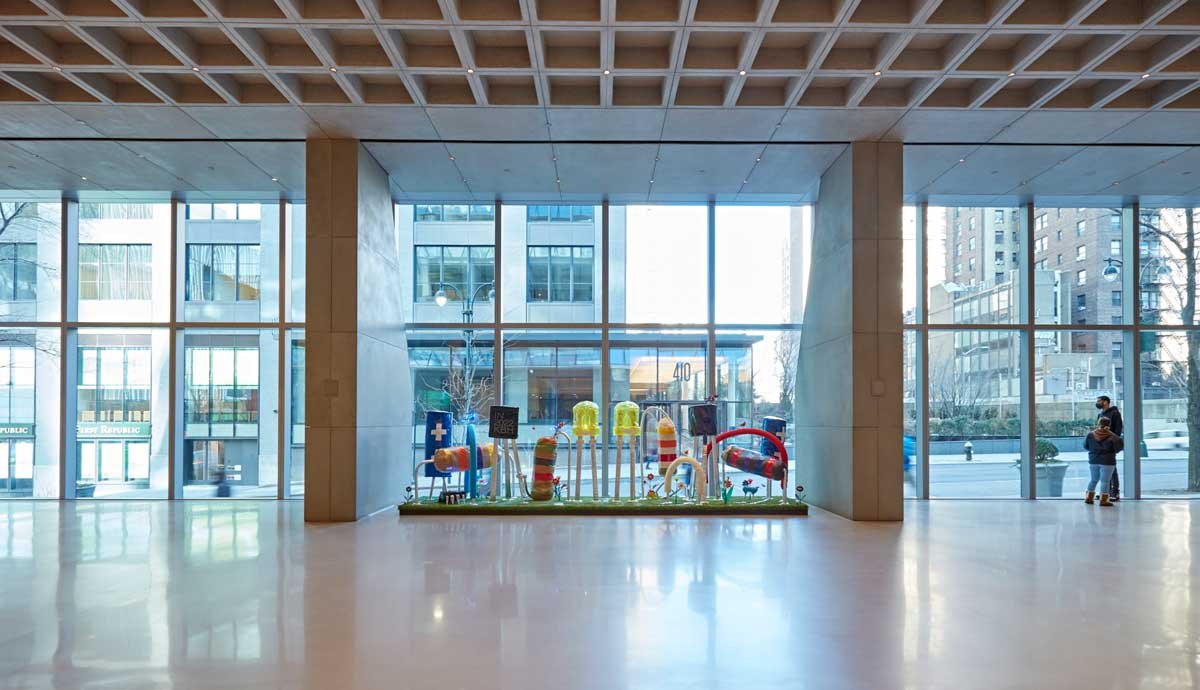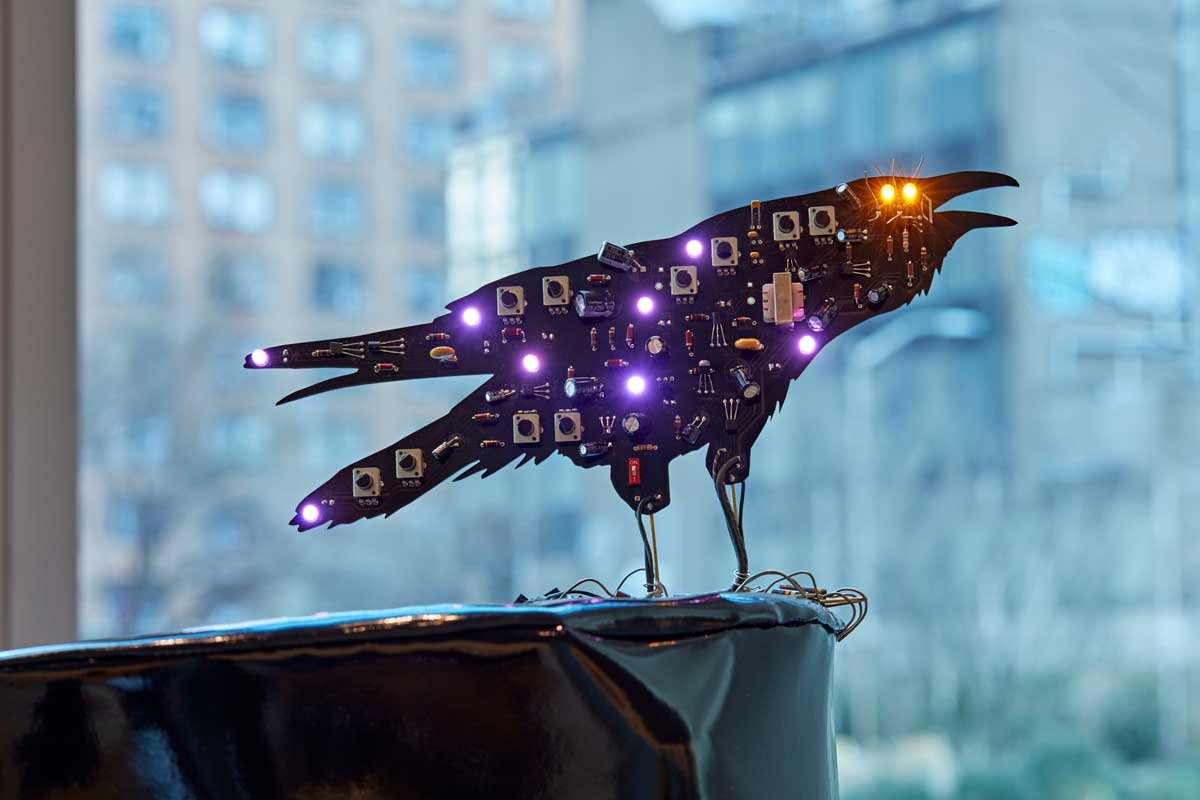circuit garden /
ONLY 4 DAYS LEFT to see my large electronic installation, “Circuit Garden,” at 5 Manhattan West (450 West 33rd Street) NYC. This photo: Me with one of my plush resistors (4.3K is a favorite color scheme). I’m wearing my screen-printed circuit dress, a power cap, and silver tabi shoes by Maison Margiela. May, 2022
The Tree of Life in Circuit Garden, 2022 /
Circuit Garden contains a sculptural “integrated circuit” (IC) that is open to reveal the inner life of electronic devices. The circuit inside of the IC depicts an ancient archetype: the Tree of Life. I was specifically inspired by Buddhist Thangka painting, which shows us that we are all connected in a universal system. Spiritual enlightenment beckons us to see through the illusion of separateness and discover that we are all facets of the same source energy: the many faces of God, the branches of one cosmic tree. The universe is a circuit, and we are its electronic components.
Design file for The Tree of Life in Circuit Garden, 2022. Notice that the base of this circuit is the composition for the entire sculptural installation. In terms of electrical engineering, the circuit traces form an “astable multivibrator oscillator,” which is a type of circuit that creates a vibrating waveform with a frequency and shape determined by the resistor and capacitor values used in the circuit. How fitting that the version of Arduino I used is called “Uno.” Indeed, the Tree of Life teaches us that we are all one (uno). Kelly Heaton, 2022
In our world of everyday technology, integrated circuits are the ubiquitous “chips” that empower civilization with machine intelligence. Nearly all ICs look like black bugs on the outside, meanwhile their magic and uniqueness is hidden within this exoskeleton. If we open an IC, we are faced with a highly miniaturized circuit for which we need a powerful microscope to observe; but even with a microscope, chips are so staggeringly complex (and often proprietary) that the majority of humankind is oblivious to their anatomy. ICs are formidable “black boxes” of civilization-altering technology that is hidden from view. In fact, circuits of all types are customarily hidden from view… which makes me want to see them even more!
An IC opened to reveal the electronic magic inside. To dissect and observe this circuit (in the spirit of a naturalist) would require a specialized microscope at a minimum; and even with the right tools, it is unlikely that we could know the processor’s design architecture without the original schematics (blueprints). There are far too many intricate and interconnected components in even the simplest of processors. Complex ICs rival the human mind: Apple’s M1 Ultra has 57 billion transistors (compared with our brain — which has on average 86 billion)… although, I would argue that the analog nature of the human mind gives us infinitely greater consciousness than a digital processor could ever achieve. Photo credit: Xoneca via Wikimedia
I do not want to put my electronics in a black box; I want to demystify and use electronics for contemporary artistic expression. While most processors are incredibly complex, the design principles and functionality derives from relatively few types of components with behaviors that we can understand, such as transistors, resistors, capacitors, diodes, and inductors. Circuit Garden invites people of all backgrounds to ponder the nature and magic of electricity as a medium by presenting some of the most common electronic components in a large-scale, simple format.
The Tree of Life in my sculptural IC compared with a 555 timer IC (a favorite chip of mine and my source of inspiration). Photo Credits: Kelly Heaton, Arts Brookfield and Jason Wyche
Circuit Garden (2022) is inhabited by analog electronic sound-generating circuits in the form of birds and crickets. The sound made by these individual circuits is self-contained (generated by the circuit itself); however, their audibility is orchestrated by an Arduino-controlled panel of 11 relay switches. These relay switches are connected to the speaker wire of each bird and cricket.* Simply put: when a relay switch is on, the bird sings; and when it is off, the bird is silent (even though the circuit is still actively generating sound, we hear nothing because its speaker is not enabled). The reason that orchestration is so important to the soundscape of Circuit Garden is that it would be unpleasant for the circuits to make sound all of the time. With orchestration, the soundscape of Circuit Garden seems natural (i.e. it seems like what we expect from “nature”). *Circuit Garden contains two notable exceptions which are the Kakapo and Goose that laid the golden egg (which I will discuss in a separate post). These birds have their own, dedicated motion detectors.
Most of my current generation of bird and cricket circuits do not contain motion detectors or awareness of each other — they only generate sound. Of course, I could add awareness and sequencing to each and every circuit, but this requires significantly more electronic parts and higher cost per unit. My priority for Circuit Garden was to highlight the life-like nature of analog electronic sound generation. For this reason, I decided to consolidate the task of orchestration (sequencing) to a single “Tree of Life” circuit that connects to each of the elements via wires that run beneath the grassy platform. To do this required a lot of wiring, as shown in the partial diagram below.
Partial view of my engineering diagram for the wires and connectors that link the Tree of Life circuit to the bird and cricket circuits in Circuit Garden. Note these wires and connectors are not visible in the installation — they are beneath the grassy panel. Kelly Heaton, 2022
Another notable feature of my Tree of Life PCB is a miniature re-creation of the entire Circuit Garden composition (see image below this paragraph). If you look at the base of the Tree of Life, beneath Buddha, you will find a simple circuit that blinks two yellow LEDs — same as the large, sculptural LEDs that blink in the center of Circuit Garden. Here, in this little circuit, you can find the functionally electronic counterparts for every sculptural element of Circuit Garden. The formal composition of the installation is an astable multivibrator; my bird and cricket sound circuits are systems of astable multivibrators. This classic circuit design was invented by Henri Abraham and Eugene Bloch during World War I (source: Wikipedia). It contains only a handful of discrete electronic components: two transistors, two capacitors, four resistors, and two LEDs (which are not necessary to generate the signal vibration, but needed if you want to see it). I love the astable multivibrator as a symbol for life because everything in the universe is comprised of myriad interwoven vibrations. As Nikola Tesla said, “If you want to find the secrets of the universe, think in terms of energy, frequency and vibration.” Similarly, the third Hermetic principle states that “Nothing rests; everything moves; everything vibrates.”
As above, so below.
Circuit traces for the stable multivibrator that forms the composition of Circuit Garden (2022). This circuit also blinks the big yellow LEDs. Kelly Heaton, 2022
My Tree of Life circuit is an electronic rendering of ancient culture merging with contemporary in a continuum, wherein electricity and spirituality are the common threads. My choice of the Tree of Life motif is due to the similarity of function and meaning: all creatures on Earth are sustained by a tree of life that connects and sustains us in an ecosystem. Electricity flows through all things and gives life. The bodhisattva in the tree of life are alternately switching in-and-out of “enlightened” states as they evolve towards an understanding of the great, universal circuit in which all life is connected as one.
Detail of the Tree of Life Circuit in Circuit Garden, 2022. Pseudorandom code on the Arduino Uno feeds out to a bank of 11 relay switches (bodhisattva) that alternately switch on/off the audibility of bird and cricket circuits to create a naturalistic soundscape. Beneath the golden etching of Buddha, there is an astable multivibrator circuit (partially visible in this photograph) that forms the entire composition and concept behind Circuit Garden, 2022. Photo Credits: Arts Brookfield and Jason Wyche
Photo Credits: Kelly Heaton, Arts Brookfield and Jason Wyche. Video credits: Kelly Heaton, Arts Brookfield and Micah Joel Productions
“Circuit Garden” is on view at 5 Manhattan West (450 W 33rd Street NYC 10001) everyday 7am - 8pm through June 3.
“Circuit Garden” was Curated by Common Ground Arts and commissioned by Arts Brookfield for Manhattan West and Brooklyn Commons.
Elektor Circuit Garden Summer of 1979 /
OMG I love this Circuit Garden illustration on the cover on Elektor Magazine’s Summer of 1979 edition.
Printed Circuit Bird (Bluejay), 2022 /
My "printed circuit birds" are self-contained sound generators. The electronics are 💯 analog: no audio recordings or software are involved. By “analog” I mean that the sound is dynamically produced by the bird’s body (circuit), like a vintage synthesizer. In this video, I adjust knobs to change resistance in the circuit, thereby altering the song quality. You can think of this like adjusting neurons in a bird’s brain to alter the impulse by which it vocalizes. I am passionate about building circuits because they demonstrate the life-like qualities of electronic hardware, which is often over-looked in favor of software. I’m not sure why we abandoned analog hardware along the road to technological advancement— digital is great for what it does, but it’s not the full spectrum of creative electronics. It would require a vast amount of hardware to build a digital computer capable to execute code for birdsong like this.
Know your parts /
For those of you who don’t recognize electronic components, this guide is for you ⚡️ My installation, “Circuit Garden,” is planted with oversized sculptures of common electronic parts used in nearly every circuit ever made. Hardware components are the media fundamentals of electrical engineering and electronic art — without which we would not have computers or software. They comprise the physical anatomy of machine intelligence. These are: capacitors (electrolytic and ceramic types), transistors, resistors, LEDs, wires, and ICs (integrated circuits, aka chips). Yes, there are other important types of hardware not included in Circuit Garden (or mentioned here), but I’ll sculpt those another time 😉
Circuit Garden on Adafruit /
Thank you for the mention, Adafruit!
Circuit Garden in NYC /
“Circuit Garden” by Kelly Heaton was curated by Common Ground Arts and commissioned by Arts Brookfield for Manhattan West and Brooklyn Commons. Video courtesy of Brookfield Arts and Micah Joel Productions
Circuit Garden celebrates our electronic culture and invites us to contemplate nature – specifically human nature in symbiosis with machine intelligence. Artist Kelly Heaton presents a large-scale circuit board in the form of an artificial lawn that is “planted” with plush sculptural electronic devices. The work evokes a playful garden, or a vintage circuit board that has been enlarged to human scale. Situated in the landscape of Circuit Garden, viewers will discover smaller functional circuits that mimic animal behaviors, such as birdsong and chirping crickets. As the viewer approaches the installation to investigate further, Heaton’s analog electronic designs generate these naturalistic sounds in real time. The sonic landscape of Circuit Gardenis thus brought to life by electric vibrations of artificial origin and not recordings of real birds and crickets, as one might expect.
STATEMENT BY KELLY HEATON:
“Electronic technology is profoundly shaping our world. Many people are symbiotic with their smart phones and digital presence. Artificial intelligence is growing smarter, and our concept of “nature” is being radically transformed by engineering. Electricity is the most important invention since the discovery of fire. Yet, the art of electrical engineering is not well understood or practiced by people outside of the scientific community. I would like to invite everyone—not only engineers—into a conversation about electronic culture, nature, and the rise of machine intelligence. While most artists work with digital media, I focus my creative practice on electronic hardware because circuits are the physical body without which there would be no digital media. Like a biologist studies animals, I study circuits to understand the physiology of intelligent machines. I am inspired by Nikola Tesla’s statement, “If you want to find the secrets of the universe, think in terms of energy, frequency and vibration.” My art explores these concepts literally in the form of circuits that vibrate in naturalistic patterns. Circuit Garden pays homage to electrical oscillation, specifically to the astable multivibrator, which is my favorite method to generate life-like waveforms.”












































